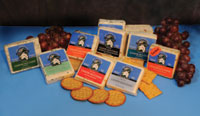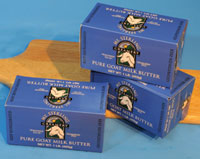 |
|||

|  |

|
|

June 14, 2013 |
||||||
Mt. Sterling Co-op Creamery adds to its product line, continues to grow |
||||||
By Kate Sander MT. STERLING, Wis. — As consumer interest and familiarity in goat’s milk cheese grows, Mt. Sterling Co-op Creamery stands ready and waiting to supply its handcrafted cheese throughout the United States. The small co-op, currently with 10 dairy goat producers, is looking to grow both in members and in customer volume, says Patricia Lund, who has handled the co-op’s sales and marketing for the past dozen years. She notes that though it’s small, Mt. Sterling Co-op Creamery has enjoyed a steady growth in production and sales since it was formed in 1976 and has enjoyed at least a 10-percent increase in sales each year during the past five years. Part of that growth has come from the co-op’s decision to expand its product line over the past several years. The co-op is best known for its signature, award-winning Cheddar-style raw goat’s milk products, the sharp variety of which won a second place at last year’s American Cheese Society (ACS) competition. In recent years, the co-op also has added a wide range of other dairy products, bringing its total offerings to 20. “The marketplace was asking for them, and diversifying was important for the stability of the company,” Lund says. In addition to its raw milk Cheddars in mild, sharp and smoked varieties, Mt. Sterling offers Country Jack in plain and seven flavored varieties as well as goat’s milk Mozzarella, Feta, pasteurized Cheddars, and Whey Cream Goat Butter.
Just as the co-op’s farmer owners practice sustainable farming methods, the cooperative’s focus is on building a sustainable company, Lund says. The co-op cuts and packages all of its cheese by hand to provide a product its customers can buy with confidence, she adds. Milk quality is closely monitored, and the co-op uses a non-GMO rennet and cultures. “Everything is tracked from the producer to the package,” Lund says, adding that because the co-op is small, she knows all of the producers and there are no questions for which she can’t quickly find the answer. The Whey Cream Goat Butter, developed back in 1994 and credited with being the industry’s first goat whey cream butter, is just one example of the co-op’s sustainable agriculture efforts, Lund says. To make the butter, the co-op’s whey cream is separated from the whey, which was originally a waste product, and churned into butter. Once the whey cream butter is churned, packaging of the butter begins. Mt. Sterling has maintained the same package design for this product throughout the years, which makes the 1-pound blue box an easily recognizable product, she says. The rich flavorful butter maintains the smooth texture associated with goat’s milk products, and it is ideal for health conscious consumers, Lund says. All natural with no colorings, the whey cream butter is snow white in appearance. The butter placed third in its class at last year’s ACS competition. In 2008, the co-op further developed its offerings by adding its “Artisan” cheese line. Mt. Sterling’s original raw milk Cheddar forms the basis for the new Artisan line. Sterling Reserve is a natural rinded raw-milk Cheddar, cave-aged a minimum of 90 days, and available in random weight daisies. It may be purchased as a single daisy, a half moon or a deli cut wedge. Sterling Reserve will complement any cheese case and is an excellent table cheese, the co-op says. In 2012, the co-op also introduced Sterling Bleu, a cave-aged raw goat’s milk Blue, and a Smoked Sterling Bleu, which was noted by a panel of food writers and journalists after the Winter Fancy Food Show in San Francisco as being an example of one of the top five food trends for 2013: “Blue Cheese Redux.” To meet consumer demand for convenience, Mt. Sterling also has introduced Artisan Blends Goat
Shreds, Feta Crumbles, and Sliced Cheddar. The co-op’s cheese is set apart by its singular focus on quality, Lund says. Being small and operated by an independent group of dairy farmers enables the co-op’s members and staff to work closely together to oversee every aspect of production. “The independent streak farmers have is seen in how the company is run,” says Lund, herself a dairy goat producer and co-op member for the past 23 years. There have been many changes and advances for the cooperative since its founding members, without a place to go with their goat’s milk, banded together and incorporated as the Southwestern Wisconsin Dairy Goat Products Cooperative in 1976. However, as the years have gone by, the close connection between the producers and their end products has remained the same. Farmers in the Mt. Sterling co-op share a general philosophy about goat farming that includes humane treatment of the animals and as much grass grazing as possible. Every producer shipping milk to the co-op is required to sign a contract ensuring they will not use growth hormones, Lund says. The co-op’s members are diverse in size, she says, with some having 60 goats and some having more than 200, but they all have something in common: They want to be farmers. Lund says the co-op would welcome more members with the same philosophy. “We like what we’re doing, and we’re going to continue producing high-quality products. We get lots of good reception,” she adds.
The co-op’s producers are located in Wisconsin and Iowa, and the co-op contracts with a hauler to pick up their milk and deliver it to the cheese plant in the tiny southwest Wisconsin village of Mt. Sterling. The cheese is crafted by two cheesemakers, Brian Unseth and Larry Domenqet, at a small cheese factory that celebrated 100 years of production in 2012. The co-op purchased the plant in 1983. It is now starting to outgrow the plant, and late last year the co-op announced plans to expand its facilities with additional factory, retail and dry storage space. The co-op has purchased a property adjacent to the factory and is renovating a house on the property to accommodate retail operations and dry storage, both of which had been housed in the cheese factory. Mt. Sterling Co-op Creamery’s cheese is available across the United States for retail and wholesale. The co-op also works with a number of distributors, Lund says. Lund attends a number of trade shows and believes in doing a lot of product sampling to spread the word about Mt. Sterling Co-op Creamery’s products. “Sales materials alone aren’t the same as getting the product into the hands of buyers and consumers,” she says. CMN
|
||||||
| CMN article search |
|
|
© 2025 Cheese Market News • Quarne Publishing, LLC • Legal Information • Online Privacy Policy • Terms and Conditions
Cheese Market News • Business/Advertising Office: P.O. Box 628254 • Middleton, WI 53562 • 608/831-6002
Cheese Market News • Editorial Office: 5315 Wall Street, Suite 100 • Madison, WI 53718 • 608/288-9090
 COUNTRY JACKS —Mt. Sterling Co-op Creamery offers a wide selection of flavored Country Jack cheese made with goat’s milk.
COUNTRY JACKS —Mt. Sterling Co-op Creamery offers a wide selection of flavored Country Jack cheese made with goat’s milk.